Edinburgh, Lothian Road, St Cuthbert's Church
Burial Vault (17th Century), Church (19th Century), Church (18th Century), Commemorative Stone (16th Century), War Memorial(S) (20th Century)
Site Name Edinburgh, Lothian Road, St Cuthbert's Church
Classification Burial Vault (17th Century), Church (19th Century), Church (18th Century), Commemorative Stone (16th Century), War Memorial(S) (20th Century)
Alternative Name(s) Nisbet Vault; King's Stables Road; St Cuthbert's Parish; West Church; West Kirk; War Memorial Chapel; War Memorial Plaque
Canmore ID 52639
Site Number NT27SW 17
NGR NT 24819 73607
Datum OSGB36 - NGR
Permalink http://canmore.org.uk/site/52639

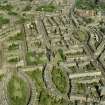
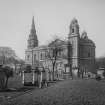
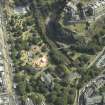
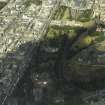
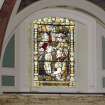

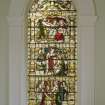

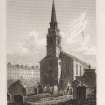


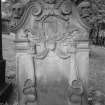
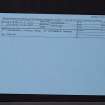
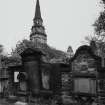
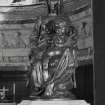





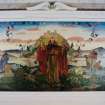

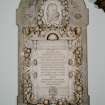


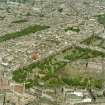
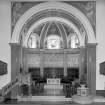
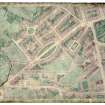
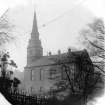
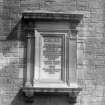
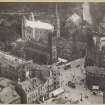
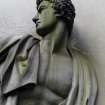
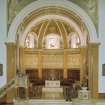
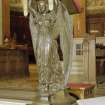


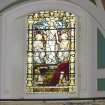


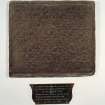




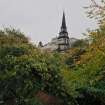




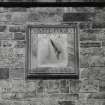

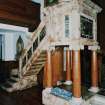

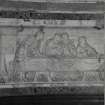
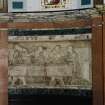

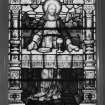




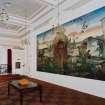
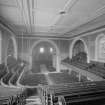
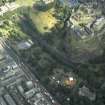
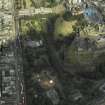

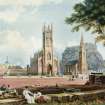
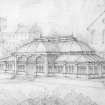
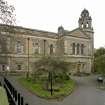
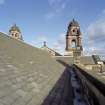
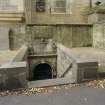
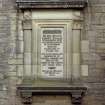
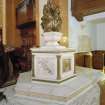
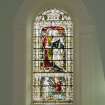
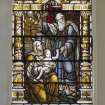
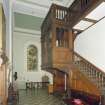
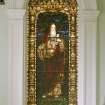
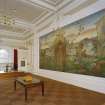

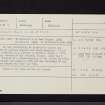

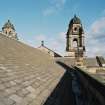
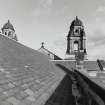

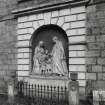

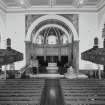





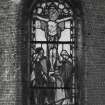
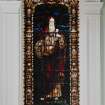

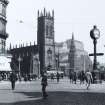

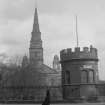
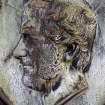
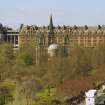
First 100 images shown. See the Collections panel (below) for a link to all digital images.
- Council Edinburgh, City Of
- Parish Edinburgh (Edinburgh, City Of)
- Former Region Lothian
- Former District City Of Edinburgh
- Former County Midlothian
NT27SW 17.00 24819 73607
NT27SW 17.01 24851 73554 Church Hall (Bank)
NT27SW 17.02 24760 73546 Watchtower
NT27SW 17.03 24909 73486 Toolhouse
NT27SW 17.04 24878 73560 Burial ground
There is no trace of the old church.
Visited by OS (JLD) 28 December 1953.
NT27SW 17.00 (NT 24819 73607) St Cuthbert's or West Church (NAT)
on Site of (NAT) St Cuthbert's Kirk (NR)
OS 6" map, Edinburghshire, 1st ed., (1853).
In all probability St Cuthbert's Church was founded by Malcolm Canmore and Queen Margaret. It is first recorded in a charter of David I, dated c. 1127. Nothing remains of the medieval fabric. Only the W tower remains of a reconstruction of the church in 1774; the steeple was added in 1789 and the remainder of the present church was built in 1893. RCAHMS 1951; G Hay 1957.
ARCHITECT: Hippolyte J Blanc, 1893 (reconstruction of 1774 church)
A F Balfour Paul - monument
A Handyside Ritchie - sculptor - monument to Dr Dickson
Robert Wright - extension to Manse to West, 1828
See NMRS Collections SK/Ferg/10, Ferguson Sketch Book 10 for pencil sketch of St Cuthbert's, insc: 'Steeple of the West Kirk. Edinburgh.' and also detail of sundial insc; 'Dial on W. face of Steeple. West Kirk. Edinburgh.'
NMRS Print Room
Inglis Photograph Collection, Acc No 1994/90
Interior view towards apse
Monument in the churchyard, Thomas Dequincey (also Rufus Woodward)
NMRS Print Room
W Schomberg Scott Photograph Collection, Acc No 1997/39
General view of the church and 2 details of monuments in the churchyard
REFERENCE:
NMRS
St Cuthbert's Parish Church
Plans I G Lindsay Collection, W/35
Ex-EUE-M Lantern Slides - see Collection
Edinburgh, St Cuthbert's Parish, land to be taken by North British Railway from Wm. Bonar Esq.
NMRS REFERENCE.
PLANS:
Dick Peddie and MacKay, Edinburgh.
Bin 12, Bag 1.
u/s, 1865.
SCOTTISH RECORD OFFICE
Repairie of St Cuthbert's Kirk and Kirkyard dykes.
Receipt for ?15.5.4 as part of stent.
24 December
1627 GD150/3236/19
Papers concerning the building of the new Church 1773 - 1776 GD 69/210
[some details follow]
Contract between the Heritors and James Weir, wright in Tolcross, for the building of a new church.
1773 GD 69/210/(a)/7
Estimate by James Wier, Architect, for the new Church.
1773 GD 69/210/(b)/24
Valuation of the stones of the Old Church at ?16.
1773 GD 69/210/(b)/36
Accounts from Robert Burn for superintending the work of masons and from William Key, Carpenter.
1774 - 1775 GD 69/210/(b)/37
Account of dues to James Weir, Architect. They amount to ?3,366. 2. 1.
1776 GD 69/210/(b)/24
PLANS
St Cuthbert's Churchyard,
Monument to J Scott Junr.
Dick Peddie & MacKay, Edinburgh new building
Bin 4, Bag 2 Peddie & Kinnear 1871
Monument to Thos. Rankin
Dick Peddie & MacKay, Edinburgh new building
Bin 4, Bag 2 Peddie & Kinnear 1863
Monument to E S Gordon
Dick Peddie & MacKay, Edinburgh new building
Bin 4, Bag 2 Peddie & Kinnear n.d.
Monument to Alexander Campbell
Dick Peddie & MacKay, Edinburgh new building
Bin 4, Bag 2 Peddie & Kinnear n.d.
Monument to Robt. Balfour
Dick Peddie & MacKay, Edinburgh new building
Bin 4, Bag 2 Peddie & Kinnear 1860
Monument to Sir Jas. Gardiner Baird, Bart.
Dick Peddie & MacKay, Edinburgh new building
Bin 4, Bag 2 Peddie & Kinnear 1864
(Undated) information in NMRS.
Publication Account (1951)
125. St. Cuthbert's Church.
In all probability the church of St. Cuthbert at Edinburgh was founded by Malcolm Canmore and Queen Margaret (1), but it first appears in history in a charter granted by their son, David I, in or about the year 1127 (2). Nothing remains of the medieval fabric. Of a reconstruction undertaken in 1774 there survives only the west tower, the design of which has been attributed to an architect named Weir, who is conjectured to have been a pupil of the elder Adam (3). When Arnot wrote (4) the tower had been carried no higher than the roof of the church and the graceful spire that surmounts it may be assigned to the year 1789, since that date is carved below each of the four clock-faces at its base. Beneath the pediment on the W. face of the tower is a tabular sundial bearing the date 1774 and the motto VIVITE FUGIO ("Live ye, I fly."). The tower is built of rubble with polished ashlar dressings, but on the W. face scabbled ashlars take the place of the rubble infilling of the sides. The spire is of polished ashlar throughout.
CHURCHYARD MEMORIALS.
The following memorials are attached either to the church or to its outbuildings.
(1) The Nisbet vault. On acquiring the estate of Dean the Nisbet family, which had formerly buried at Greyfriars, claimed to be the principal heritors of the West Kirk or St. Cuthbert's. Having no ground there, William Nisbet, second laird of Dean, petitioned the heritors and kirk-session in 1645 for a burial place, and was assigned an area of five ells by three beside the N. door of the church. In 1691 Henry Nisbet, second son and successor to Sir Patrick Nisbet of Dean, obtained a grant of this ground on which he proposed to erect a burial vault with stones quarried in the churchyard itself, agreeing to pay a gratuity of £39 10S. od. for the privilege.
The vault that he built still exists on the N. side of the church, at the foot of a steep flight of straight steps. The entrance is a simply-moulded archway with projecting keystone and impost-blocks. Above the cornice is a weatherworn monogram probably of the initials of H(enry) N(isbet) and his first wife C(hristian) R(iddell), enclosed at the top by a skull and thigh-bone and at the sides by scrolled cartouches. The dexter cartouche is charged: A chevron, between three boars' heads erased, ensigned with the saltire and lion rampant of the baronets of Nova Scotia, for Nisbet. The sinister cartouche is charged: A chevron between three ears of rye, slipped and bladed, for Riddell. On a panel above the skull is incised the inscription: HENRICUS NISBET, A DEAN IUNIOR, / FAMAM PLURIS QUAM OPES, / VIRTUTEM PLURIS QUAM FAMAM HABENS, / TERRENA DESPICIENS, CAELESTIA SPIRANS; / LETHI MEMOR; ANASTASIN EXPECTANS; / VIVUS IPSE VIDEN(S)QUE; / HOC SIBI SUISQ(UE) MONUMENTUM SEPULCHRALE CONSTRUXIT, / ANNO DOMINI MDCXCII /
AEQUA LEGE, VOCANT REGEM CUM PAUPERE FATA;
CUNCTA FLUUNT, VIRTUS UNICA FIXA MANET,
HUIC ERGO DONES VITAM, SUPER ASTRA VEHENDUS,
MORTIS ET ADDISCAS JURA SEVERA PATI.
("Henry Nisbet, younger, of Dean, setting fame above wealth and virtue above fame, despising earthly things and hoping for heavenly joys, remembering death, waiting for resurrection, while still himself alive and open-eyed, set up this sepulchral monument for himself and his family in the year of our Lord 1692.
The Fates summon king and beggar impartially,
All things are fleeting, virtue alone stands fast,
Therefore, if you would rise beyond the stars,
devote your life to virtue
And school yourself to bear the stern dispensation of death").
An elaborately-carved armorial panel is built into the wall of the church immediately above the vault. It displays a scrolled cartouche supported on the dexter side by a savage, wreathed round the middle and the head and holding a baton, and on the sinister by a greyhound, and is surmounted by helm, mantling and wreath, with a boar passant for crest. Over all is a weatherworn label inscribed [I BYDE] IT. It is charged for Nisbet as above and seems to have been flanked by Henry Nisbet's initials set in the two top corners of the panel. The initials S(ir) H(enry) N(isbet), and those of his first wifeC(hristian) R(iddell), are repeated in monogram above; the date 1692 also appears in two places, in the one case carved in raised figures and in the other incised (5).
(2) A small square panel inscribed RELIGIONI ET /POSTERIS IN / MINISTERIO S ("Sacred to religion and to my successors in the ministry") R P G A* 1594, and with the initials M and M S S incised upon its lower margin, is built into the N.E. corner of St Cuthbert's Church Hall.
(3) A tablet commemorating the Rev. Robert Pont, which has been removed to the vestibule of the church from a burial enclosure, bears the following epitaph:
ILLE EGO ROBERT(VS) PONTA/ N(VS) IN HOC PROPE
SACRO /
CHRISTI QVI FVERAM PASTOR / GREGIS AVSPICE
CHRISTO /
AETERNAE HIC RECVBANS EX/PECTO RESVRGERE VITAE
("I am that Robert Pont who was shepherd of Christ's flock in the adjacent church. I lie here in the sure hope that with Christ's blessing I shall rise again to life everlasting") followed by OBIIT DIE [OCTAVO] 8 MEN/SIS MAII ANNO D(OMINI) 1608 / AET[ATIS] 81 ("He died on the eighth day of May, in the year of our Lord 1608, aged 81"). In the churchyard itself are a number of memorials erected from the years immediately before and after the Union, up to the present day. Those earlier than 1707 are enumerated here.**
(I) A headstone with a scrolled top, which has been incorporated in a later memorial. It bears the initials R F on both sides of the pediment and the following inscription on a cartouche on the front: "HERE LYES JOHN FINLAY / MARCHANT BURGESS IN /EDINBURGH WHO DEPAR/TED THIS LIFE UPON THE /8TH DAY OF NOVEMBER 1699 / HIS AGE 26 YEARS." A much worn cartouche on the obverse bears lines which were read as follows by Maitland (6): "O DEATH! 0 GRAVE! WHY SO SEVERE? EV'N YOUTH MUST SEE THY LOOK AUSTERE. THIS YOUNG MAN DID BY LIVING DIE, BY DEATH HE LIVES ETERNALLIE." The verses are followed by the date 1699.
(2) A mural monument in a burial enclosure, having a shaped base enriched with funerary emblems, an architectural framework with side-scrolls, and a curved pediment enclosing in the tympanum a cartouche with an elaborate monogram of the initials D R J F. Between the composite shafts, which rise on either side, is an arched panel enriched with cherub's heads in the spandrels and bearing an inscription, now partly illegible, which Maitland read as follows: "TO THE LASTING MEMORY OF DAVID RENNY, PORTIONER AND BREWER, SOMETIME BAILLIE OF PORTSBURGH, WHO . DEPARTED THIS LIFE 25TH APRIL 1705 IN THE 54TH YEAR OF HIS AGE. HE LEFT BEHIND HIM 12 CHILDREN BROUGHT FORTH TO HIM BY JANE FERGUSON, HIS SPOUSE, WHO ERECTS AND DEDICATES THIS MONUMENT FOR THE USE OFTHEMSELVES AND THEIR POSTERITY I COR. XV. v. 55 57. BY HIM WHOSE CONQUESTS THRO' THE WORLD AREKNOWN, I TO MY FIRST ORIGINAL AM THROWN. MY EARTH LIES HERE, MY BETTER PART'S ABOVE, AND LIVES, SO I, NOT DEATH, THE CONQU'ROR PROVE :YET LET THE STINGLESS KING OF TERRORS BOAST,OF WHAT HE'S WON, AND WHAT HE THINKS I LOST,HE THAT'S ALMIGHTY, AND FOR EVER TRUE,ENGAG'D THIS DUST SHOULD RISE AND CONQUER TOO,WHAT I POSSESS SECURES ME WHAT'S TO COME.MY CLAY SHALL BE REFINED, THEN SENT FOR HOME."
(3) A table tombstone ornamented with the emblems of mortality and bearing at the foot a monogram, apparently of the initials of Andrew Biggar and Jean Livingston, with two inscriptions. The lower of these is illegible, but the upper reads HEAR LYES ALEXANDER / BIGGAR, BREWER IN CAIRN HElD [GAIRNSHALL ?] WHO / DEPARTED THIS LYFE THE /THIRTEENTH DAY OF MARCH / 1704, HIS AGE 41 YEARS.
(4) Three recumbent slabs bearing inscriptions which are now wholly illegible. The emblems of mortality depicted upon them suggest a date at the beginning of the 18th century.
RCAHMS 1951, visited c.1941
(1) Hannay, St. Cuthbert's Kirk and its Saint, p.11 (2) Lawrie, Early Scottish Charters, p. 59. (3) Transactions of the Edinburgh Architectural Association, ii,p. 220. (4) History, p. 277. (5) Cf. O.E.C., i, pp.117-20. (6) History, p. 179.
*The initials R P strongly suggest Robert Pont, who is commemorated on stone No. 3. A further connection with Pont is provided by the facts that this stone's original position was, according to Monteith (An Theater of Mortality, p . 76), "on the South-west Corner of the principal Mans belonging to the Minister there, "and that Pont built a manse for St. Cuthbert's in 1593. (Sime, History of the Church and Parish of St. Cuthbert, pp. 32f.). G A M and M S S cannot, however, be explained as applying to any of his three wives, his colleagues, or his successors, and the meaning of all the letters consequently remains uncertain.
**A complete catalogue has already been published by the Scottish Record Society (The Monumental Inscriptions in St. Cuthbert's Churchyard, Edinburgh, 2 vols., compiled by John Smith.)
Publication Account (1981)
This church, lying to the north and west of the Castle Rock, was the original parish church of Edinburgh (Duncan, 1975, 465). St. Cuthbert's, which probably dates from the eleventh century (RCAM, 1951, 185), was granted by David I to Holyrood Abbey, a grant confirmed by Robert, Bishop of St. Andrews, c.1130 (ESC, 1905, 75). Its strategic position helped in three separate sieges of Edinburgh Castle: in 1573, 1650 and 1689. When the present church came to be built in 1892-4, the foundations of at least six earlier churches were found (Anon, 1960, 16), although nothing visible remains of its medieval fabric (RCAM. 1951, 185).
Information from ‘Historic Edinburgh, Canongate and Leith: The Archaeological Implications of Development’ (1981).









































































































